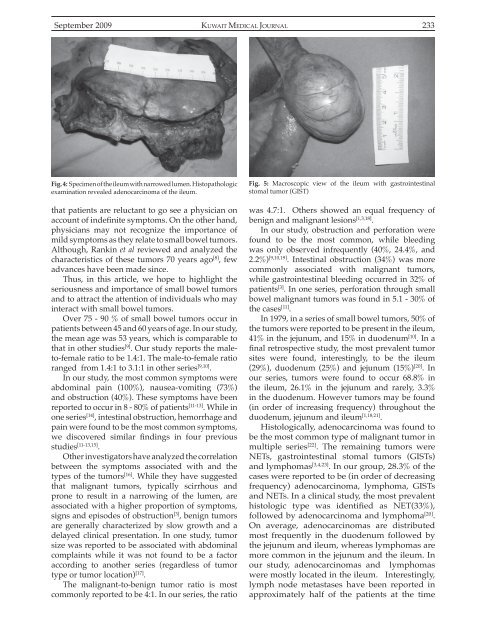Vol 41 # 3 September 2009 - Kma.org.kw
Vol 41 # 3 September 2009 - Kma.org.kw
Vol 41 # 3 September 2009 - Kma.org.kw
You also want an ePaper? Increase the reach of your titles
YUMPU automatically turns print PDFs into web optimized ePapers that Google loves.
<strong>September</strong> <strong>2009</strong><br />
KUWAIT MEDICAL JOURNAL 233<br />
Fig. 4: Specimen of the ileum with narrowed lumen. Histopathologic<br />
examination revealed adenocarcinoma of the ileum.<br />
that patients are reluctant to go see a physician on<br />
account of indefinite symptoms. On the other hand,<br />
physicians may not recognize the importance of<br />
mild symptoms as they relate to small bowel tumors.<br />
Although, Rankin et al reviewed and analyzed the<br />
characteristics of these tumors 70 years ago [8] , few<br />
advances have been made since.<br />
Thus, in this article, we hope to highlight the<br />
seriousness and importance of small bowel tumors<br />
and to attract the attention of individuals who may<br />
interact with small bowel tumors.<br />
Over 75 - 90 % of small bowel tumors occur in<br />
patients between 45 and 60 years of age. In our study,<br />
the mean age was 53 years, which is comparable to<br />
that in other studies [9] . Our study reports the maleto-female<br />
ratio to be 1.4:1. The male-to-female ratio<br />
ranged from 1.4:1 to 3.1:1 in other series [9,10] .<br />
In our study, the most common symptoms were<br />
abdominal pain (100%), nausea-vomiting (73%)<br />
and obstruction (40%). These symptoms have been<br />
reported to occur in 8 - 80% of patients [11-13] . While in<br />
one series [14] , intestinal obstruction, hemorrhage and<br />
pain were found to be the most common symptoms,<br />
we discovered similar findings in four previous<br />
studies [11-13,15] .<br />
Other investigators have analyzed the correlation<br />
between the symptoms associated with and the<br />
types of the tumors [16] . While they have suggested<br />
that malignant tumors, typically scirrhous and<br />
prone to result in a narrowing of the lumen, are<br />
associated with a higher proportion of symptoms,<br />
signs and episodes of obstruction [3] , benign tumors<br />
are generally characterized by slow growth and a<br />
delayed clinical presentation. In one study, tumor<br />
size was reported to be associated with abdominal<br />
complaints while it was not found to be a factor<br />
according to another series (regardless of tumor<br />
type or tumor location) [17] .<br />
The malignant-to-benign tumor ratio is most<br />
commonly reported to be 4:1. In our series, the ratio<br />
Fig. 5: Macroscopic view of the ileum with gastrointestinal<br />
stomal tumor (GIST)<br />
was 4.7:1. Others showed an equal frequency of<br />
benign and malignant lesions [1,3,18] .<br />
In our study, obstruction and perforation were<br />
found to be the most common, while bleeding<br />
was only observed infrequently (40%, 24.4%, and<br />
2.2%) [9,10,19] . Intestinal obstruction (34%) was more<br />
commonly associated with malignant tumors,<br />
while gastrointestinal bleeding occurred in 32% of<br />
patients [3] . In one series, perforation through small<br />
bowel malignant tumors was found in 5.1 - 30% of<br />
the cases [11] .<br />
In 1979, in a series of small bowel tumors, 50% of<br />
the tumors were reported to be present in the ileum,<br />
<strong>41</strong>% in the jejunum, and 15% in duodenum [10] . In a<br />
final retrospective study, the most prevalent tumor<br />
sites were found, interestingly, to be the ileum<br />
(29%), duodenum (25%) and jejunum (15%) [20] . In<br />
our series, tumors were found to occur 68.8% in<br />
the ileum, 26.1% in the jejunum and rarely, 3.3%<br />
in the duodenum. However tumors may be found<br />
(in order of increasing frequency) throughout the<br />
duodenum, jejunum and ileum [1,18,21] .<br />
Histologically, adenocarcinoma was found to<br />
be the most common type of malignant tumor in<br />
multiple series [22] . The remaining tumors were<br />
NETs, gastrointestinal stomal tumors (GISTs)<br />
and lymphomas [3,4,23] . In our group, 28.3% of the<br />
cases were reported to be (in order of decreasing<br />
frequency) adenocarcinoma, lymphoma, GISTs<br />
and NETs. In a clinical study, the most prevalent<br />
histologic type was identified as NET(33%),<br />
followed by adenocarcinoma and lymphoma [20] .<br />
On average, adenocarcinomas are distributed<br />
most frequently in the duodenum followed by<br />
the jejunum and ileum, whereas lymphomas are<br />
more common in the jejunum and the ileum. In<br />
our study, adenocarcinomas and lymphomas<br />
were mostly located in the ileum. Interestingly,<br />
lymph node metastases have been reported in<br />
approximately half of the patients at the time
















